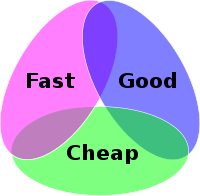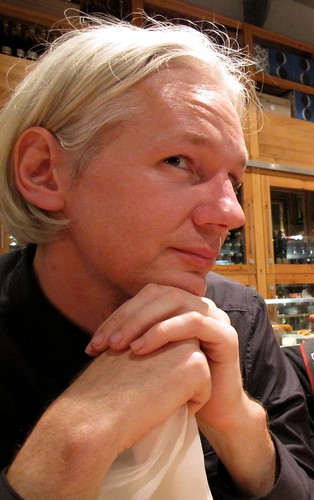Open Source War on Poverty
One thing that can be said about Julian Assange is that he is effective at radical transparency. Large hierarchical organizations (militaries, corporations) now fear for their secrecy. John Robb has a good article on Assange today: …what’s really interesting about Wikileak’s Julian Assange is that he is one of the most important innovators in modern conflict alive today. A true global guerrilla. In other words, he’s a person that has effectively adapted modern methods of warfare/conflict to engage and defeat the biggest nation-states in the world. Robb uses the language of warfare a lot – which can be offputting. But if you translate “warfare” into “conflict” you are entering the world of Sun Tzu’s Art of War, where conflict is a natural part of human life, and is not good or evil. What matters is how to achieve a victory that can “take whole,” subdue conflict while doing what is right for all people involved: Therefore, one hundred victories in one hundred battles is not the most skillful. (The Art Of War, Denma Translation, Chapter 3: Strategy of Attack) This is very interesting when you consider major human problems as the “enemy”: poverty, warfare, disease, starvation, oppression. Robb says in another article on Open Source Warfare: Open source warfare is an organizational method by which a large collection of small, violent, superempowered groups can work together to take on much larger foes (usually hierarchies). It is also a method of organization that can be applied to non-violent struggles. It enables: Here I think Robb is using the word violent to mean “acting with or marked by or resulting from great force or energy or emotional intensity,” not necessarily causing physical harm to anyone. This has application to the “war on poverty” – following Robb’s ideas, and Assange’s lead, if we actually want to eliminate poverty from the world, we’d start a movement of open-source wealth creation that had the characteristics outlined above, an open source war on poverty. It would be able to innovate quickly, be resilient, centerless, and would quickly swarm around key opportunities, key points where progress can be made quickly and on wide scale.
Subduing the other’s military without battle is the most skillful.
Your online vote can help end poverty
Your vote on American Express’ website will help us win a $200,000 grant – we’ll use that money in our quest to end world poverty. Vote here (after clicking the link, you need to register the first time you vote). For more information about why you should vote, one of our interns Fred Graves made this informative and entertaining video!
Customer Development and Social Business
Great post on Business Model Alchemist on using Customer Development for social business. This is what we’re doing where I work at the Grameen Foundation’s Mifos Initiative, as I described in a post a few days ago. Business Model Alchemist does an imaginary case study for the very real PeePoo company, makers of a biodegradable bag you can use as a portable toilet. PeePoo is trying to mitigate the problem of flying toilets that are found in slums worldwide – the practice of peeing or pooping in a plastic bag, and throwing it into the air away from your house. It’s a significant problem, because more than 2 billion people live without access to basic sanitation. The BMA article covers a couple of important points: Peepoople, for example, has a proven product/technology that works and was tested – the Peepoo bag. However, the company acknowledges that this is only a starting point. The management team knows that it has to think through several possible business models in order to find one that is sustainable AND has a substantial impact… The Customer Development process assumes that many of the initial assumptions about your business model are probably wrong, which you will find out in the second step of the process, Customer Validation. It is only when you start testing a business model or aspects of it with customers that you will find if your hypothesis were right or wrong. Hence, the Customer Development Process builds in an iteration loop to fix the shortcomings of your business model. Eric Ries, who built on Steve’s work, coined this business model iteration loop the Pivot.
Reliably producing greatness using multipersonal entities
Richard Hamming gave a talk on what it takes to be individually great. He says,
In summary, I claim that some of the reasons why so many people who have greatness within their grasp don’t succeed are: they don’t work on important problems, they don’t become emotionally involved, they don’t try and change what is difficult to some other situation which is easily done but is still important, and they keep giving themselves alibis why they don’t. They keep saying that it is a matter of luck. I’ve told you how easy it is; furthermore I’ve told you how to reform. Therefore, go forth and become great scientists!
It’s a long talk, but well worth reading. It does point the way for individual greatness. This is in reach of many people, although there currently aren’t many people who want to follow that path. But we do need a reliable way to produce greatness – great solutions to the many problems humanity is facing. But how? The best idea I have is – that it’s through teams. Not just any team, but teams that can consistently produce great results or output the way the few great people do each generation. Hamming cites some great scientists, since that’s his field: Fourier, Ampère, Watt. Shannon, Fermi, Teller, Feynman. There are analogous teams. I will call these “multipersonal entities.” This is a term originated by Jim and Michele McCarthy to describe teams that can aggregate the greatness of their members without being hindered by the non-great parts. Teams like this can also spread the personal growth that is necessary to be great among the team members, lowering the barriers to greatness. I was telling a friend about this, and he said, “It just sounds impossible.” But it’s not. In a conversation today, Michele said, “I want team psychology to be as well understood and commonly used as individual psychology. I want it to be well known how to create great teams.” And I think she also meant, I want it to be standard practice that you use great teams to solve great problems, and standard practice to create them when you need them. This sounds impossible, eh? Hamming says, One of the characteristics of successful scientists is having courage. Once you get your courage up and believe that you can do important problems, then you can. If you think you can’t, almost surely you are not going to. Therefore, go forth and become a great team! (Thanks to Cal Newport for getting me to re-read this before I talked with Michele yesterday.)
The Art of the Pivot
So it was 101 days ago that I attended Eric Ries‘ Startup Lessons Learned conference. Going to that conference set off a chain of events, which is why I haven’t posted since then. The SLLConf morning session was all on Agile, and since my team is 100% Scrum and Extreme Programming, I didn’t go. I did go to afternoon sessions, though, and in particular, the ones on the Customer Development case studies were brilliant – Dropbox (which I use and love); PBWorks; and Food On The Table. Each presenter started out describing their business, each making slow progress. But slow progress is death to a startup. So they found ways to accelerate their feedback loop, their OODA loop. They all got it down to weeks or even days. Days! This means, find a customer problem, come up with a solution, test and build software, ship it to customer, see how it works, and do it again, in days! I also know Eric’s last company, IMVU, did the same. This is the essence of Lean Thinking. And the whole time at SLLConf, I was thinking, I am doomed! I am doomed! Because my business is too damn slow. At Mifos, we sell (er, sold) enterprise software, installed on-premise, to medium sized microfinance banks (50k-500k end-clients each). The implementations take up to 6 months. I can only do 2-3 implementations at a time. My software releases take 3 months each, and customers don’t even install them right away. How the hell can I pivot anything? The feedback loop is too slow. Especially when I compared myself to the SLL case study companies – these were companies moving at web speed, shortening their learning cycles, and learning and pivoting like mad to find a business model. So before the conference the Mifos leadership team had all read Steve Blank’s book, Four Steps to the Epiphany. And we had been discussing customer development and trying to implement it. But with little success. The “I am doomed!” thoughts made for a miserable few weeks. However, as a team we realized that if we couldn’t learn faster, and pivot faster, we would really be doomed instead of just thinking that. Our funders and customers wouldn’t stand for it. And we wouldn’t be able to end poverty. So we pivoted, and repositioned Mifos around hosted (“cloud”) services. Yes, pivoting is painful. I think it’s important to make it less painful, I’ll say more about that in another blog post. Our app is web based, so now we host it on Amazon EC2. We are going after smaller customers (microfinance institutions, MFIs) because they’re faster to decide, faster to implement, and Grameen Foundation and other investors can actually invest in them. We are no longer selling enterprise deployments, unless they want to be implemented in the Cloud. We host the software, so we can push updates to it whenever we want, as long as we don’t break customers. We have the data, so we can tell whether what we’re doing is helping or hindering MFI success. We are also building a version of IMVU’s “cluster immune system” of stages of automated tests mated with a cloud provisioning system to support rapid pushes of software to our test, staging, and production servers. We already had continuous integration so we can build on that knowledge. We just did our first 5-day on-site deployment (down from 6 months!) in India with an MFI there, Light Microfinance. And we got another small Mexican MFI, Podemos Progressar, up in 5 days with no on-site visit at all. It will take another several months or so to see if these MFIs are actually doing well using the software. Meanwhile we have a bunch more small MFIs in the pipeline and aiming to do simultaneous developments which would vastly increase our capacity. We are going to rebuild our team structure around Customer Development and Lean Startups. We also have some cool ideas about what software and changes we can make so we can go even faster. And along with that we’ve been collaborating closely with a couple of other Grameen Foundation departments, Social Performance Measurement which does the Progress Out of Poverty Index methodology for measuring whether a microfinance institution is helping people raise themselves out of poverty, and Capital Markets Advisory Committee, which invests in socially responsible, fast growing MFIs. We have more hypotheses we’re testing, and I’ll say more about those in coming weeks and months as they become public. In the meantime, check out our new Mifos.com website that explains much of this! It’s been an exhausting, exhilarating, and sometimes painful 101 days. And we still have a lot to learn!
Resilience and Complexity
Alex Steffen weighs in on reslience and complexity:
Forget gardening suburban lawns — help us redesign urban foodsheds for millions. Forget cohousing — help us retrofit an entire districts with green buildings, clean energy and green infrastructure. Forget biodiesel — help us plan a whole new regional transportation systems. Forget ecocity ideas about making your neighborhood look like nature — help us densifying our existing cities, changing how they connect to ecosystems so they work like nature. Forget light green frugality, household tips and small steps — help reveal the backstory of the lives we lead and trigger a revolution in sustainable design, post-ownership and genuine prosperity. Forget countercultures. Make the real culture better.
Helpful and wasteful social complexity
When constraints change radically, society sheds complexity. The complexity that stays is not waste. We keep complexity that people find valuable. So that’s another distinction that matters to me: helpful complexity and wasteful complexity. Wasteful complexity, cruft, muda – if you can remove the waste before it becomes too great and drags you down, you can navigate your way to another stable state. So what are examples of social complexity that are waste, muda? Here’s the start of my list: I’m sure you have yours, and the list goes on. These are social systems that suck energy, but give back no or even negative value. Our taxes pay Blackwater, for instance, and all we’re getting out of that is social instability. There is social complexity that adds value: And this leads me to another problem that I call the “bitter anarchist problem.” In my mind it’s exemplified by Derrick Jensen, but could easily be applied to many “leftists” these days. The problem is this: many leftists and anarchists complain bitterly about the way society is today, but then do little or nothing to change society. Business is powerful in the world today because businesses ship products and services. Shipping products organizes peoples’ thinking, lives, and work in a particular way – the people who ship them, buy them, and even the people who don’t buy them, but live in the society that coexists with them. What a company ships expresses its viewpoint on how life ought to be for people. Buying the products and services, you give energy to that company to make it more effective at creating the vision it is expressing. In this way, businesses grow organically, using the wealth created from the products to feed new investment in innovation or expansion. Corporations use this methodology to create systems that siphon wealth from one group and hand it to another; we can use it to create wealth and distribute it equitably. We can argue whether this system has been helpful or wasteful, but it does exist, and we participate in it. So if we want to have an effect on what kind of world we live in, and our children live in, I think we need to ship products and services and systems of living that embody the world we want. We don’t have to use the control structures of oppression to do it. The nature of information economies helps decentralized organizations, because digital information can be copied and distributed freely at low cost. But we do have to ship. I haven’t seen many leftists or anarchists who do this. Perhaps that is because they have a different conception of work: work is something to avoid, to hate, to fight against. It’s factory work – dull, routine, dangerous. It kills the planet. You can see this in the labor-management struggles of the 1800s and 1900s. But that’s not how all work has to be. Work is now dominated by information. Better ideas can radically transform a team, a business, a society. And to get better ideas, you need creativity. Creativity doesn’t thrive under oppression, it thrives under safety and freedom. Teams and organizations that learn to use this to their advantage will have a lot of influence on our society. But people don’t yet know much about organizing effective work in the information age. Lean Manufacturing is one idea, and Eric Ries‘ Lean Startup movement is another, a lively green shoot growing up out of the Agile software development movement. I’d put Y Combinator and the Hacker News community close by. For me, the answer isn’t clear yet. I want to combine the Core Protocols with Lean Startups to get fun, non-coercive, highly-effective, profitable companies with triple bottom lines – caring for people, planet, and profit. They would be similar to Bruce Sterling’s global civil societies, or maybe John Robb‘s resilient communities. Why the Core Protocols? It’s the best actionable way I’ve found to create truly great teams. Built in to the Core is non-coercion and personal growth, so teams that adopt it are ready for shipping products and services for this information age. But it’s also a way to reduce wasteful complexity. Over at Hacker News, and other places, people often wonder how to scale a company beyond the founding team. Why do many companies grow less effective as they grow bigger and older? How do you keep that energy and effectiveness alive? To grow, many companies put in place structures to keep order – processes and rules that can keep peoples’ effort moving in the same direction, but often stifle creativity and decision-making. Another related question is, how can you stay small but still be radically effective? How can you create great products quickly, and ship them often, without having a huge team? Or another way to say this, how can you have wide effect, without having to incur a lot of muda, a lot of work that adds no value? The way to do that from the viewpoint of the Core Protocols is to spend your team’s energy on getting to and staying in a state of shared vision. Want to live in a peaceful world, where people are happy, the water is clean, and the forests huge and un-cut? Ship it.
Anne makes the distinction between technological complexity and social complexity. They’re not the same, though they depend on each other intimately. Technological complexity is related to what kind of machines we can build; social complexity is related to how our society functions. The rule of law, democracy, and corporations all fall under social technology.


Computers and Cars and Complexity
“I think computers and the internet are going down. And I won’t change my mind until I see new computers and new ways of connecting them that are simpler and more resilient than the ones we have now. […] These innovations are possible in theory, but I don’t expect them. I expect cars and computers to become less and less reliable, and slowly withdraw to the wealthiest areas”
Ran, it seems to me that you look at our world that is dominated by energy-wasting, polluting, oppressive manufacturing corporations, and imagine that it’s all going down in a cascading collapse as the conditions that support them start to degrade. Just as you can’t prove that it will, I can’t prove there are other more likely scenarios… I am personally afraid of the eco-fascists, companies that are able to operate under different constraints – low resource usage, low energy, low pollution, high violence. Corporations are resilient too. But there are still other ways things may go. Do you ever hang out with Makers? Hobbyists, tinkerers, artists, ham radio enthusiasts, people who actually ship things? That urge is there all over the world, and it’s irrepressible. People make bikes, computers, radios, and cars in their garages. If the assembly-line factories go down, people will be making things on a smaller scale. Yes, the incredible stream of cheap plastic crap will slow down and stop, but people will be making things that matter to them: kitchen knives, bicycles, solar cells, communication gear. Have you ever heard of Minix? The kernel is about 6,000 lines of code; the rest of the system is not much bigger. It’s a full POSIX operating system (like Linux) with a complete Internet protocol stack – that means it can do pretty much anything your desktop computer can do. It’s modular and easy to understand, and concise enough to even type into a terminal from a paper book if you had to do that. And it’s not the only simple operating system out there. These days people write Internet-capable operating systems as a hobby. (FreeDos, Haiku, ReactOS) As for resilient communication systems, the Internet is just too useful to let go of, I think… it’s going to be around for a while in some form. Anyone remember Fidonet? These things are still doing Internet mail in Africa and the USSR. One reason is that they are simple and can work on the crappy telecommunications infrastructure there. But another is that because they are simple, they are hard for the “authorities” to stamp out. And yeah, cars and computers and fiber-optic cables are currently based on our industrial system, and that’s very brittle. But people aren’t brittle. And all that stuff can be made in garages – look at hobbyist computers, and kit cars. Every major city in the world has people who can make and repair things. Why don’t they build simpler things now? The system is tilted against them. In the case of cars, it’s because of the regulatory system. In the case of computers, I think it’s the economies of scale in chip making. When the constraints change and the system starts breaking down – the tinkerers are going spring up in the cracks. You imagine that only the wealthiest areas will have advanced technology. I imagine that advanced technology is everywhere – in the poor areas too – and that people use that technology to make the lives that they want.  Ran writes,
Ran writes,
Refactoring Civilization
I recently read Clay Shirky’s eloquent article The Collapse of Complex Business Models. Shirky summarizes Joseph Tainter’s The Collapse of Complex Societies, relating societies to businesses. According to Tainter, Jared Diamond, Ran Prieur, and many dystopian science fiction writers, when societies shed complexity, it happens in a catastrophic fashion. As part of the science fiction book The Caryatids, set in 2060, Bruce Sterling tosses off the fact that to reduce its complexity, China killed off 500 million people – mainly its old and infirm. Other writers imagine chaos, war, and burning cities. Software programs have many of the problems Shirky mentions in his post:
In such systems, there is no way to make things a little bit simpler – the whole edifice becomes a huge, interlocking system not readily amenable to change. Tainter doesn’t regard the sudden de-coherence of these societies as either a tragedy or a mistake—”[U]nder a situation of declining marginal returns collapse may be the most appropriate response”, to use his pitiless phrase. Furthermore, even when moderate adjustments could be made, they tend to be resisted, because any simplification discomfits elites. When the value of complexity turns negative, a society plagued by an inability to react remains as complex as ever, right up to the moment where it becomes suddenly and dramatically simpler, which is to say right up to the moment of collapse. Collapse is simply the last remaining method of simplification.
(via John Robb) But there are other ways out of this mess. Software developers have a technique called refactoring that is often used to combat complexity. Left unchecked, each modification of a program moves it toward more complexity. But good programmers keep cleaning house – every so often, you need to go in and purposefully reorganize, eliminate cruft, and simplify. Refactoring reduces complexity of software without adding anything new. Often it feels good, since achieving a new level of understanding lets you do the same task in a much simpler way – or a new perspective lets you combine several similar things into one simpler piece of code. And sometimes it’s painful – understanding a mess of complicated spaghetti code is hard, and finding new solutions is often even harder. But without it, you end up with a big ball of mud that will collapse eventually. Turning a working program that uses the “big ball of mud” design pattern into a something that’s simple, supple, and easy to change – well, that’s an art. It’s especially hard when there’s a lot of money running through your software, like the program I work on at Grameen Foundation, Mifos. Though Shirky doesn’t say it, business as a whole does have a way of reducing complexity without systemic collapse – via disruptive innovation. Disruptive innovation, as detailed in Clayton Christensen’s book Innovator’s Dilemma is actually a non-violent process. Companies may go out of business, but no one loses their life. The problem with complex societies is that the collapse of civilizations has been violent. We need ways to simplify without causing violence, or starvation, or mass suffering. One way is via business model changes – Paul Hawken, Amory Lovins, and Hunter Lovins say in their book Natural Capitalism that ecological companies will win out over those that aren’t ecological. Another is via other movements, such as the huge do-it-yourself movement (popularized by Make magazine and Cory Doctorow‘s book Makers). When you can print out or machine complex industrial parts in your garage, and sequence genes and make transistors at home, you don’t need huge factories anymore. That’s refactoring industries. So how do you avoid war, famine, and chaos? One way is to reduce population. Curiously, a really great way to do that is educate girls and women, and raise peoples’ standard of living – in other words, eliminate poverty. When people are not poor, they have fewer kids. Fewer kids means fewer people consuming fewer resources. So eliminating poverty is one way of refactoring society. The sooner we can do that, the less risk of a whole-society crash we will have. Another might be another idea from Bruce Sterling’s Caryatids, the rise of global civil societies, organizations that take care of people the way governments do now. Another is Paul Romer’s Charter Cities, a 21st century version of the Hanseatic League – where nations team up to create new city-states that can reimagine the social contract for people in their supply region. I get angry when I see us being mediocre – accepting war, violence, starvation, oppression, ecological devastation. As with big-ball-of-mud software, we have to think big – if we don’t think big, people will add complexity faster than we can take it away. So that’s why I’m interested in greatness – how to get teams of people, and teams of teams, and even larger groups, thinking big, and acting effectively at that scale. We need to ship big, great innovations. We need to think big to refactor our civilization, to reduce its complexity in a non-violent way.

These are all innovations. That’s what I think Ran and many “pro-crash” writers miss (such as the Archdruid)- it is possible to innovate our way out of trouble, if we can see the complexity and reduce it fast enough. Our economy isn’t based on energy anymore – it’s based on information. And with economies based on information, you can change all three sides of the cost-time-quality triangle, not just two sides.




